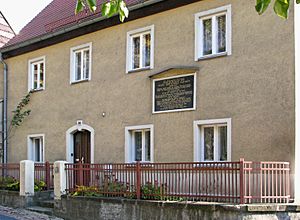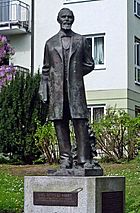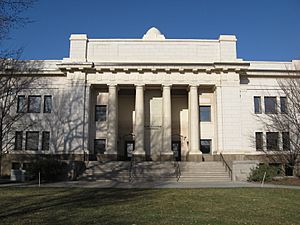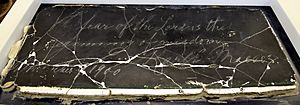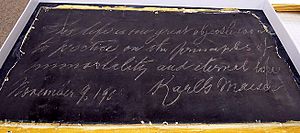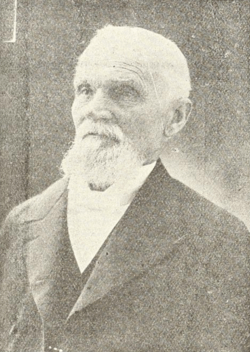Karl G. Maeser facts for kids
Quick facts for kids
Karl G. Maeser
|
|
|---|---|
 |
|
| Principal of Brigham Young Academy (later becoming Brigham Young University) |
|
| In office August 1876 – January 1892 |
|
| Preceded by | Warren Newton Dusenberry |
| Succeeded by | Benjamin Cluff |
| Personal details | |
| Born | January 16, 1828 Meissen, Germany |
| Died | February 15, 1901 (aged 73) Salt Lake City, Utah, United States |
| Spouses |
|
| Children | 8 |
Karl Gottfried Maeser (born January 16, 1828 – died February 15, 1901) was an important teacher in Utah. He was a member of The Church of Jesus Christ of Latter-day Saints (LDS Church). He led Brigham Young Academy for 16 years. Even though he wasn't the very first principal, many people see him as its true founder. The Academy later became Brigham Young University (BYU) in 1903.
Before teaching at the Academy, Maeser taught at different schools in Germany and Utah. He even taught Brigham Young's children. Maeser used a teaching method called the Monitorial System. He believed that students should all have responsibilities. Maeser was also inspired by Pestalozzi's ideas about teaching. He also believed that schools should teach about religion.
Maeser was a missionary for the LDS Church in four countries. He held many leadership roles in the church. This included being the leader of the Church Educational System. He was also an important leader in the Sunday School. His ideas about education shaped Brigham Young Academy. They also influenced other church schools throughout Utah. He shared information about Utah and the church's schools at a big fair in San Francisco.
Contents
Early Life and Education
Karl G. Maeser was born on January 16, 1828. His hometown was Meissen, in Saxony, Germany. His parents were Johann Gottfried and Federicka Zocher Maeser. Karl was the oldest of four sons. His family was well known in Meissen. His father was a china painter. Karl went to public school in Meissen. When he was 11, he temporarily lost his sight for eight months. No one knows why this happened.
In 1842, Maeser went to the Kreuzschule in Dresden. He studied there for two years. Graduating from this school could have made him part of Germany's upper class. But Maeser chose to study at a special school called Friedrichstadt Schullehrerseminar. This school trained future teachers. He graduated on May 20, 1848. Maeser became a schoolteacher. He taught Protestant children in Bohemia for three years. He then returned to Dresden. He taught at the First District School. Later, he taught at the Budich Institute. There, he became a Senior Teacher.
In December 1848, Maeser was supposed to join the military for two years. However, he was declared "unfit." He didn't have any major physical or mental problems. On June 11, 1854, Maeser married Anna Mieth. She was the daughter of the director of the First District school. Their first child, Reinhard, was born in 1855. They had eight children together.
Joining The Church of Jesus Christ of Latter-day Saints
Becoming a Member
While teaching at the Budich Institute, Maeser found a book. It was called Die Mormonen by Moritz Busch. This book was against the LDS Church. Maeser and his brother-in-law, Edward Schoenfield, decided to learn more. They wanted to understand the beliefs of the LDS Church. Maeser wrote letters to church missionaries. A missionary named William Budge offered to visit Maeser's home. He taught them and answered their questions. Both Maeser and Schoenfield joined the LDS Church.
Maeser was baptized by Franklin D. Richards and Budge. This happened on October 14, 1855, in the Elbe River. Maeser was baptized at night because the church was not allowed in Germany then. He was the first person baptized into the church in Saxony. His wife, Anna, was baptized soon after on October 19. The next Sunday, a new branch of the church started in Dresden. Maeser became its first leader. The Dresden police forced his family to leave Germany in July 1856. They eventually traveled to Salt Lake City. This was where many Latter-day Saints were gathering.
Missionary Work
After leaving Germany, the Maesers went to London in June 1856. Church members there welcomed them. Maeser was asked by the church to serve a German-speaking mission in London. This was in July 1856. He and his family left London in May 1857. Their ship arrived in Philadelphia in July. Their baby son, Karl Gustav Franklin Maeser, died when they arrived. He was buried in Philadelphia.
In Philadelphia, Maeser was asked to write pamphlets. These pamphlets explained basic church beliefs. After a few weeks, Maeser was called to be a missionary. He served the German-speaking community in Philadelphia. Maeser also spent some time in Virginia during his mission. He earned money for his family by giving music lessons. Among his music students were the daughters of former U.S. President John Tyler. Maeser returned to Philadelphia with Anna. There, he was called to lead the church's conference. Maeser and his family left Philadelphia in June 1860. They traveled across the country to Salt Lake City. Maeser arrived in Utah Territory on September 1, 1860.
In 1860, church leaders asked Maeser to lead German-speaking church meetings in Salt Lake City. But soon after, most Swiss church members moved away. They went to places like Santa Clara, Utah. So, the meetings in Salt Lake City ended. He was called to serve another mission to Germany and Switzerland in 1867. On his way to Switzerland, he helped start a church branch in Paris. He was made a mission president in 1868. He also started the church magazine, Der Stern, in January 1869. When he returned to Utah in 1870, there were enough German-speaking members in Salt Lake City again. They started their own church meetings, and Maeser led them.
Teaching Career
Maeser's first teaching job was at the First District School in Dresden (1852-1853). He also taught at the Budich Institute starting in 1854. When he arrived in Utah, he continued teaching. He taught at the Deseret Lyceum. This was an academy in Salt Lake City that started in November 1860. Teachers at the Lyceum had to make school slates and clean the school. Conditions were very poor. If students' families couldn't pay tuition, Maeser often collected food instead.
In spring 1861, Maeser left the Lyceum. He was offered a job at the Union Academy. Brigham Young started this academy for older students. Young made Maeser the head of the school in February 1861. Maeser worried about schools meeting students' needs. He left the Union Academy to teach at other schools. This included the Twentieth Ward Seminary, which he started in 1862. This school became well known for training teachers.
Maeser was chosen as a leader for the University of Deseret in 1860, 1863, and 1865. In 1865, he began teaching Brigham Young's 56 children privately. He also taught other children who came to the Young home. He also kept financial records for Leonard H. Hardy to earn more money. He was teaching at Young's family school when he was called on a mission to Germany in 1867. He left for Europe in May 1867, leaving his family with little money.
Maeser returned to Salt Lake City in 1870. He became a German professor. However, he left this job to go back to the Twentieth Ward Seminary. In 1870, he also taught at the University of Deseret. He helped create their teacher training program. Maeser wrote articles in the Beehive Series for the Juvenile Instructor in 1870. In 1871, he was elected president of the Salt Lake Teacher's Association. For a short time, he was also an assistant organist for the Mormon Tabernacle Choir.
Leading Brigham Young Academy
In 1875, Brigham Young Academy in Provo, Utah, was founded. Its goal was to teach both regular subjects and religious principles. The Academy followed advice from Joseph Smith: teach correct principles and let students learn to manage themselves. Warren Newton Dusenberry was the first temporary principal. Then, Brigham Young chose Maeser to be the founding principal. The Academy later became Brigham Young University.
When Maeser arrived at Brigham Young Academy in 1876, fewer students were enrolled. The buildings were old, there was no system for records, and no set schedule. Only 29 students started in Maeser's first term. But this number doubled by the end of the term. He was the only teacher during that first term. Maeser agreed to teach for $1200 per year. The first year of his leadership had four terms. Maeser wrote reports at the end of each term. He sent them to the church leaders in Salt Lake. These reports described lesson plans and classes.
Under Maeser, the school had different departments. These were based on students' abilities. The lower levels included Primary, Preparatory, Intermediate, and Kindergarten. Primary students were 6 to 8 years old and new to school. The Primary classes were replaced by the Preparatory Department in 1888. This department started with a fourth-grade reading level. The Intermediate Department was for students aged eight to eleven. It accepted students who finished the Primary Department. The higher levels of the Academy included the Academic Department and the Normal School. The Academic Department offered many classes. It allowed students to focus on one subject. The Normal School trained teachers. Maeser personally oversaw the Normal School.
Maeser also set up a daily routine. Morning exercises started at 9 a.m. Classes began at 9:30 a.m. Students had 30 minutes for lunch. The school day ended at 4 or 5 p.m. Over 3,000 different students attended the Academy while Maeser was its principal.
Maeser was very strict. Students at the Academy had to follow high moral standards. They had to follow the Word of Wisdom. However, they were responsible for their own actions under an honor system. Maeser also created training courses for teachers. He kept parents informed. He sent them monthly reports on their children's progress.
In 1884, the Lewis building, where the academy first met, burned down. Reed Smoot, a former student, told Maeser, "Dr. Maeser, the academy is no more." Maeser replied, "No such thing, it's only the building... The academy lives on." Maeser used the fire to teach a lesson about pride. He had a dream that inspired new buildings for the Academy. The school struggled financially for a while. Maeser thought about leaving. But he had a dream, or vision, where he saw "Temple Hill filled with buildings—great temples of learning." This inspired him to stay at the Academy.
Maeser had a big impact on his students. One student, Alice Louise Reynolds, wrote that "he had the ability to inspire." She said he made students feel life was important. He told them the Lord sent them to do special work. He also said proper preparation was needed for that mission. Famous students who studied under Maeser include George Sutherland, William H. King, Bryant S. Hinckley, James E. Talmage, George Albert Smith and J. Golden Kimball. He also inspired his family. One of his sons, Karl Emil, studied with Maeser. He became a respected teacher and school president. Maeser retired from Brigham Young Academy in 1892. He wanted to focus on his role as Superintendent of Church Schools. Benjamin Cluff took his place.
Shortly before he died, Maeser was asked to speak at the Maeser School. This public school was named after him. He wrote his message on four chalkboards. It said:
- 1. The fear of the Lord is the beginning of all wisdom.
- 2. This life is one great object lesson to practice on the principles of immortality and eternal life.
- 3. Man grows with his higher goals.
- 4. Let naught that is unholy ever enter here.
These chalkboards are kept at Brigham Young University.
Leader of Church Schools
In April 1888, the Church Board of Education was created. This was part of the LDS Church. Maeser had suggested it in 1887. Maeser became a member of the board. Later, he was made the superintendent of the Church Educational System. The Board of Education was created to manage church schools. This position is now called the Commissioner of Church Education. As Superintendent, Maeser helped set up rules for new church academies. He also helped train teachers. He gave ideas for how new school buildings should look. By 1889, Maeser oversaw 19 schools. These schools operated under the academy system. In 1889, the Church Board of Education created a group to certify teachers. This group gave Maeser a special degree that same year. Maeser also kept writing in the Juvenile Instructor in the 1890s. He wrote to explain church education policies.
During this time, Maeser also served in the leadership of the Deseret Sunday School Union. He was the Second Assistant to General Superintendent George Q. Cannon from July 1894 to January 1899. Then he was the First Assistant to Cannon from January 1899 until February 1901. Maeser also took part in the Utah constitutional convention after Abraham O. Smoot died in 1895. He suggested a rule to support prohibition (banning alcohol).
Sharing Information at the Mid-winter Fair
LDS Church missionaries had been removed from California in 1858. This was because of the Utah War. Missionary work started again in 1892. Maeser led the California mission from January to August 1894.
Maeser's main job was to lead the Utah exhibit at the Mid-winter Fair in San Francisco in 1894. He was serving as Superintendent of Church Schools at the time. This fair was like the Chicago World's Fair of 1893. At the Chicago fair, the church showed minerals and food from Utah. In San Francisco, Maeser chose to focus more on church beliefs. He also showed the educational achievements of students in the church school system. The church had an exhibit in the Manufacturers and Liberal Arts Building. Maeser gave talks to get more attention for the church school exhibit. Utah's participation in the fair tried to gain support for it to become a state. He and his helpers shared information about Utah's history. No one was baptized into the church while Maeser was president of the mission. However, he did help create friendlier public relations between Utah and California.
Maeser's Teaching Ideas
Maeser did not agree with John Locke's ideas about education. Locke thought education was only for the rich. Maeser knew that Johann Bernhard Basedow had good ideas. Basedow believed in treating students kindly and not using physical punishment. However, Maeser believed that "come, follow me" was better than "you must." In Maeser's view, Basedow was not a good example.
The Monitorial System
Maeser used the Monitorial System in his teacher training. This system came from Andrew Bell and Joseph Lancaster. It suggested that older students could help teach younger ones. It also said that a classroom should be set up so one teacher could watch many students. Maeser thought this system had a flaw. He felt it focused too much on being efficient and not enough on each student's unique needs. Maeser believed teachers should have more personal talks with students. He used his version of the monitorial system. In it, each student was responsible for something or someone else. This made students think beyond themselves. It helped them learn responsibility and organization.
Pestalozzi's Ideas
When Maeser was at the Friedrichstadt Teacher College, he learned about Pestalozzi's ideas about education. These ideas greatly influenced him. Pestalozzi's theory recognized that every person has potential. Pestalozzi encouraged teachers to be kind and respectful to students. He wanted them to show love, not cause fear. Pestalozzi also believed in education for everyone. He was against educating different social classes separately. Maeser adopted many of these ideas. He supported education for women. Maeser believed students should be able to express themselves freely. He also thought they should choose their own careers. His talks tried to involve students. He helped them understand ideas through their own experiences. He also used many object lessons. These lessons helped students observe their surroundings and make connections. Maeser admired Pestalozzian teachers Adolph Diesterweg and Friedrich Fröbel. Maeser also agreed that "education should be balanced head, heart and hand."
The Role of Religion
Maeser believed that religion was very important in true education. He saw each student as a child of God. He believed each child had unique abilities and potential. He thought all schools should include some religious teaching. He also argued that public high schools should have extra religion classes. However, Maeser respected other religions. Even though Brigham Young Academy and Brigham Young University included LDS Church beliefs.
Legacy and Impact
Maeser's health was getting worse, but he kept working. He died at his home on February 15, 1901. He was an example of dedication and faithfulness. His ideas about education, the honor system, and including religious classes are still used at Brigham Young University. The Maeser Building at BYU is named after him.
A song was written to remember Maeser. It was called "Come, Lay His Books and Papers By." Annie Pike Greenwood wrote the words, and L. D. Edwards wrote the music. This song became an LDS hymn. It was in the 1948 church hymnal as hymn number 338. After the title, it said, "In memory of Dr. Karl G. Maeser." It is not in the 1985 hymnal.
Maeser also helped create a special connection between Meissen, where he was born, and Provo, Utah. Now, these two cities are "sister cities." Both cities hope this relationship will grow. They want to exchange groups of people, like manufacturers, young people, teachers, scientists, artists, and tourists. This will help make the cultures of both cities richer. Since 2001, the two cities have sent high school students on a three-week exchange. This helps students learn more about their different societies and cultures.
Images for kids


